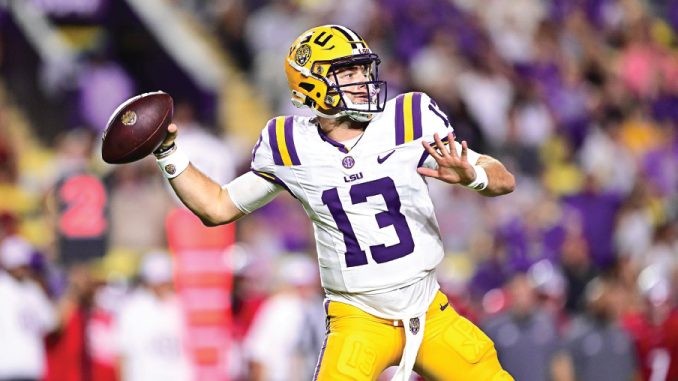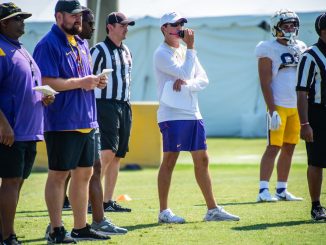
Brian Kelly said LSU’s running game is improving. The Tigers called 36 running plays against Nicholls, but only ran 21 times. Nicholls used 7- and 8-man fronts, so LSU audibled and passed the ball instead. Kelly says he’s confident in his team’s ability to run the ball. Let’s dig into that a little more.
Meanwhile, LSU’s defense took a huge hit when Jacobian Guillory got hurt. He was one of the only experienced players on the defensive line. Now, Gio Paez and Jay’Viar Suggs will be the main defensive tackles. They have some experience, but they’re not proven.
The Tigers are hoping their freshmen can step up. Freshman Ahmad Breaux has already played 30 snaps. LSU will face tough opponents from now on, but they’re clearly counting on their defensive tackles to hold on.
Guillory’s injury left a void in the defensive line. Kelly is looking for ways to adapt not just replace. He might move defensive ends inside or give more reps to other players. The problem is inexperience, but opportunities are arising.
Harold Perkins hasn’t made a big enough impact yet. The coaches are looking for ways to use him better. They know he’s proven most effective as an edge rusher, but they need him inside due to depth concerns. They’re evaluating how to free him up again. Time is running out to maximize Perkins’ skills before he goes to the NFL.
Kelly Highlights LSU’s Adaptation Against Nicholls, Revises Previous Assessment of Tigers’ Running Game
Big news from the Ponderosa: LSU’s ground attack, a point of concern earlier, now shows promise. Kelly’s film review of the Nicholls game revealed encouraging signs for the Tigers’ rushing efforts, despite early-season hurdles, he said on Monday.
LSU ran the ball 21 times for 64 yards, but Kelly pointed out that they designed 35 or 36 running plays in their 44-21 victory. He explained that Nicholls often used 7- and 8-man fronts, creating chances for Garrett Nussmeier to audible to passing plays. Nussmeier impressively threw for 302 yards and six touchdowns.
“There was a sense that we were out-physicaled, but that wasn’t the case,” Kelly said on Monday. “We chose to pass because it was the best option for this game. We didn’t want to run into a crowded box just to prove our strength.”
While they have adopted a new running game strategy that benefits from an experienced offensive line, LSU has recorded only 47 carries for 181 yards in its first two games, averaging 3.85 yards per rush.
“We have complete confidence in our offensive line’s ability to push through defenders,” Kelly reassured. “When it was necessary, we executed well. I feel very confident about that.”
Kelly also noted that LSU opponents mainly used Cover 1 defense with extra defenders close to the line. He encouraged offensive coordinator Joe Sloan to focus on plays that take advantage of the other team’s strategies instead of just trying to showcase their physical strength.
In the game against Nicholls, Kelly explained that four of Nussmeier’s passes acted as extensions of their running game. Because of the packed box, Nussmeier quickly threw the ball to the outside. The team also has run plays that incorporate hitch routes for similar scenarios.
“This is all about how teams choose to defend us,” Kelly emphasized. “They have been stacking the front more often, which has led us to rely on our passing game.”
What Jacobian Guillory’s Injury Means For The LSU Defense
LSU’s defense took a massive hit with the announcement that defensive tackle Jacobian Guillory would miss the entire season with a torn Achilles. Guillory, a fifth-year senior, was one of the only returning players with experience on the defensive line.
Kelly and staff spent much of the offseason shopping around the transfer portal for impact defensive tackles. LSU came up short for the services of highly touted transfers Domanic Williams and Simeon Barrow, but LSU managed to land Gio Paez and Jay’Viar Suggs.
Paez and Suggs brought much-needed experience and offered a significant boost to LSU’s depth up front. Paez ended up winning a starting job next to Guillory. Now, with Guillory’s injury, Suggs joins Paez on the first line.
This area was a concern for LSU entering the year. Even with Guillory, Paez and Suggs aren’t proven at an SEC level. Paez was a rotational player playing predominately as an end at Wisconsin while Suggs is moving up from the Division II level.
Paez and Suggs are now positioned to be the focal points of LSU’s defensive line. It’s hard to read much into what we saw against Nicholls State, but Kelly said he was impressed by the defensive tackles in the USC contest. Paez and Suggs weren’t disruptors, but they avoided huge mistakes and didn’t get pushed around by a good USC offensive line.
Still, Guillory was LSU’s best defensive tackle by a decent margin. He was a blue-chip recruit with significant SEC experience. He’s proven to be a stopper who can help plug the run. After an offseason with Bo Davis, he was primed for a career year.
That’s hard to replace.
As LSU’s SEC schedule gets underway, the Tigers will face some of the best offensive lines in the country. Most OL’s LSU sees will have a better overall talent level than LSU’s interior defensive line.
The Tigers have some promising freshmen at this spot. But they’re just that — freshmen.
Ahmad Breaux has already played 30 snaps through two games, which comes as no surprise after Kelly said he was one of LSU’s most ready freshmen, physically and mentally.
If Breaux is ahead of schedule and Paez and Suggs hold their own, LSU may be able to hold on. There will be some rough games, sure. But LSU is hoping it can live with that trio as its base.
That’s counting on a lot to go right, though. Breaux will have some growing pains and Suggs’ transition from D-II to the SEC won’t be seamless.
LSU will get another test this Saturday when it travels to South Carolina, but that’s just the start of an SEC schedule that won’t offer many breaks.
LSU’s Defensive Line Faces A Critical Juncture
Guillory’s departure clearly leaves a void in the Tigers’ ranks no matter how you look at it. Kelly acknowledges the challenge: “He wasn’t a dynamic pass rusher, but we knew his strengths.”
The solution? A mix of adaptation and promotion. Washington no doubt steps in, notching three tackles against Nicholls. But keep in mind Washington was on the scout squad prior. Freshman Dominick McKinley, a local standout, may also see action.
But Kelly’s strategy evolved as he talked: “We might move defensive ends inside for extra reps.” Paris Shand and Gabe Reliford emerge as top candidates. Reliford, impressive in preseason, recorded four tackles against Nicholls.
The problem persists no matter how Kelly sliced it: inexperience in the defensive tackle position. Yet opportunities arise. Kelly emphasized, “We don’t replace; we complement.” This approach could unlock new potential in the lineup.
As LSU prepares for their SEC opener against South Carolina, the defensive reshuffle continues. Reliford’s battlefield promotion seems imminent. So, also, does the personality of LSU defensive line with Guillory gone and Blake Bakers’ penchant for pressuring and wreaking havoc. Think more rushing and pressuring. More gambling.
What About Harold Perkins?
The clock is also ticking for LSU to unlock the full potential of their star linebacker Harold Perkins before his likely departure to the NFL after this season. Despite being touted as a game-changing talent after his impressive freshman campaign, the junior Perkins has struggled to make his usual impact through the first two games of 2024.
As Kelly and his staff desperately search for ways to better utilize the athletic freak, a cloud of uncertainty looms over the Tigers’ defense. In his Monday press conference, Kelly revealed they are considering shaking up personnel across the secondary and even moving players like Sage Ryan from cornerback back to safety, his natural position, to get their best athletes on the field. However, the lingering question remains – what is the best way to deploy Harold Perkins?
The coaching staff knows Perkins is at his most disruptive when turned loose as an edge rusher. His rare blend of size, speed and physicality made him unblockable at times as a freshman, racking up sack after sack from the outside linebacker position. However, with depth concerns at inside linebacker, LSU was forced to move Perkins inside this season to get its best linebackers on the field in natural rotations together.
So far, the results have been underwhelming.
While Whit Weeks, Perkins’ backup, has impressed shedding blockers against the run, Perkins hasn’t found many splash play opportunities from his new inside role. His impact has been negated, stuck sifting through trash rather than attacking offensive tackles off the edge. Kelly acknowledged the staff is going “back and forth” evaluating if they need to get creative to free up Perkins once again.
As LSU enters the teeth of its brutal SEC schedule, starting with a road test against South Carolina, the urgency is increasing. They know they likely only have 10-11 games left to maximize Perkins’ other-worldly skillset before he departs for the multi-million dollar riches of the NFL. After a season and two games of so-so output, LSU is running out of time to recapture the magic of Perkins’ freshman season and make this campaign a truly special one.




Be the first to comment